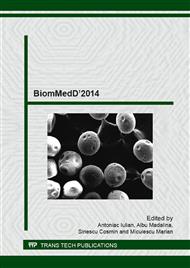p.286
p.296
p.303
p.310
p.316
p.322
p.327
p.333
p.339
Increased Resistance to Mechanical Shock of Metallic Materials by Metal-Ceramic Surface Coatings
Abstract:
In the last time, material engineering in lately developed the design and processing technology of materials in well-defined goals. Thus, they designed and achieved the metal alloys for use in strong fields required mechanical shock using methods of surface engineering. In this direction, we have developed very superficial deposition techniques by thermal spray of ceramic and metal powders, both for hard coating and to protect surfaces in refractory environments. In a controlled manner, can form new structures, which leads to an improvement in the tribological properties of the coatings obtained. In this paper are described experimental results obtained after the tests of resistance to mechanical shock testing of metal-ceramic coatings on forged titanium support. We analyzed the behavior of thermal deposited layers of ZrO2 stabilized with 8% Y2O3 and Al2O3 after applying mechanical shock test and scratch test. These materials were analyzed in terms of structural, of mechanical properties and adhesion of the surface layers using electron microscopy, X-ray diffraction, Charpy device, CETR UMT-2 tribometer. The results showed that the materials investigated have a stratified columnar structure, shows lamellar and intra - lamellar cracks and pores formed between neighbor "splat's". From microscopic analysis, after these tests, it was observed that the thermal deposited layers were not separated and there was a fingerprint on their surface. The experimental results show that the new structures obtained presents much better mechanical properties compared to the material, forged titanium, no deposit.
Info:
Periodical:
Pages:
316-321
Citation:
Online since:
March 2015
Authors:
Keywords:
Price:
Сopyright:
© 2015 Trans Tech Publications Ltd. All Rights Reserved
Share:
Citation:


